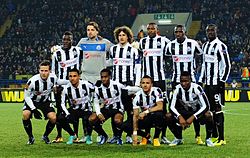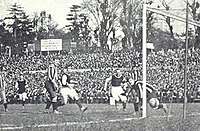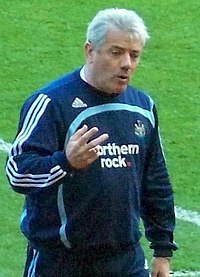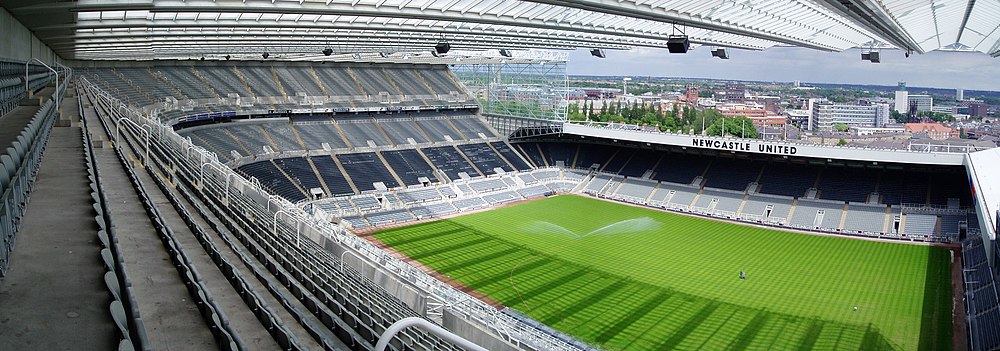Newcastle United F.C.: Difference between revisions
| (One intermediate revision by the same user not shown) | |||
| Line 2: | Line 2: | ||
|name=Newcastle United Football Club | |name=Newcastle United Football Club | ||
|nickname=The Magpies | |nickname=The Magpies | ||
|picture= | |picture=Metalist-Newcastl (5).jpg | ||
|logo= | |logo= | ||
|founded=1892 | |founded=1892 | ||
|ground=St James' Park, Newcastle upon Tyne | |ground=St James' Park, Newcastle upon Tyne | ||
| Line 178: | Line 178: | ||
}}</ref> | }}</ref> | ||
The current club crest was first used in the 1988–89 season. The crest includes elements from the coat of arms of the city of [[Newcastle upon Tyne]]; the two sea horses representing the city’s strong connections with the sea, the castle representing the city's [[The Castle, Newcastle|Norman keep]].<ref>{{cite web | The current club crest was first used in the 1988–89 season. The crest includes elements from the coat of arms of the city of [[Newcastle upon Tyne]]; the two sea horses representing the city’s strong connections with the sea, the castle representing the city's [[The Castle, Newcastle|Norman keep]].<ref>{{cite web | ||
|url=http://www.nufc.co.uk/page/Club/History/ClubCrest | |url=http://www.nufc.co.uk/page/Club/History/ClubCrest | ||
Latest revision as of 13:05, 11 September 2015
| Newcastle United Football Club “The Magpies” | ||||

| ||||
|---|---|---|---|---|
| Founded: | 1892 | |||
| Chairman: | Lee Charnley | |||
| Manager: | Steve McClaren | |||
| Ground: | St James' Park, Newcastle upon Tyne | |||
| Capacity: | 52,405 | |||
| League: | Premier League | |||
| Website: | http://www.nufc.co.uk | |||
Newcastle United Football Club is a professional association football club based in Newcastle upon Tyne in Northumberland.
The club's distinctive black and white striped shirts, based on the livery colour of the City of Newcastle, have earned the club the nickname "The Magpies" though it is more popularly known as Toon (from "Newcastle Town" pronounced in the Geordie manner).
The club was founded in 1892 by the merger of Newcastle East End and Newcastle West End, and has played at its current home ground, St James' Park, ever since. The ground was developed into an all-seater stadium in the mid-1990s and now has a capacity of 52,405.[1][2]
Newcastle United has been a member of the Premier League for all but two years of the competition's history, and has never dropped below football's second tier since joining the Football League in 1893. The club has been owned by Mike Ashley since 2007, succeeding long term chairman and owner Sir John Hall.
Newcastle have won four League Championship titles and six FA Cups, as well as the 1969 Inter-Cities Fairs Cup and the 2006 UEFA Intertoto Cup. Newcastle United has the ninth highest total of major honours won by an English club.[3] The club's most successful period was between 1904 and 1910, when they won an FA Cup and three of their First Division titles. The club is the twentieth richest club in the world in terms of annual revenue, generating €115.3m in 2012. Historically, Newcastle's highest placing was in 1999 when they were the fifth richest in the world, and second in England only behind Manchester United.[4] Recently the club have been highly successful in the Premier League in the 1990s and early 2000s, but have been mostly struggling since the 2006–07 season, and have been relegated once in 2009.
The Magpies have a fierce local rivalry with Sunderland. The club's traditional kit colours are black and white striped shirts, black shorts and black socks. Their traditional crest takes elements of the city coat of arms, which features two grey seahorses.
History
Early history

The first of football being played on Tyneside dates from 3 March 1877 at Elswick Rugby Club. Later that year, Newcastle's first football club, Tyne Association, was formed. The origins of Newcastle United Football Club itself can be traced back to the formation of a football club by the Stanley Cricket Club of Byker i November 1881. This team was renamed Newcastle East End F.C. in October 1882, to avoid confusion with the cricket club in Stanley, County Durham. Rosewood F.C. of Byker merged with Newcastle East End a short time later. In 1886, Newcastle East End moved from Byker to Heaton. In August 1882, Newcastle West End F.C. formed from West End Cricket Club, and in May 1886, the club moved into St James' Park.[5] The two clubs became rivals in the Northern League. In 1889, Newcastle East End became a professional team, before becoming a limited company the following March.[6] However, on the other hand, Newcastle West End were in serious financial trouble and approached East End with a view to a take over. Newcastle West End were eventually dissolved, and a number of their players and backroom staff joined Newcastle East End, effectively merging the two clubs, with Newcastle East End taking over the lease on St James' Park in May 1892.[5]
With only one senior club in the city for fans to support, development of the club was much more rapid. Despite being refused entry to the Football League's First Division at the start of the 1892–93 season, they were invited to play in their new Second Division. However, with no big names playing in the Second Division, they turned down the offer and remained in the Northern League, stating "gates would not meet the heavy expenses incurred for travelling".[5][6] In a bid to start drawing larger crowds, Newcastle East End decided to adopt a new name in recognition of the merger.[5] Suggested names included Newcastle F.C., Newcastle Rangers, Newcastle City and City of Newcastle, but Newcastle United was decided upon on 9 December 1892, to signify the unification of the two teams.[5][7] The name change was accepted by the Football Association on 22 December, but the club was not legally constituted as Newcastle United Football Club Co. Ltd. until 6 September 1895.[6] At the start of the 1893–94 season, Newcastle United were once again refused entry to the First Division and so joined the Second Division, along with Liverpool and Woolwich Arsenal.[5] They played their first competitive match in the division that September against Woolwich Arsenal, with a score of 2–2.[6]
Turnstile numbers were still low until the 1895–96 season, when 14,000 fans watched the team play Bury. That season Frank Watt became secretary of the club, and he was instrumental in promotion to the First Division for the 1898–99 season. However, they lost their first game 4–2 at home to Wolves and finished their first season in thirteenth place.[6]

Staring from 1903–04, the club grew to dominate football for almost a decade, the team known for their "artistic play, combining team-work and quick, short passing". Long after his retirement, Peter McWilliam, the team's defender at the time, said "The Newcastle team of the 1900s would give any modern side a two goal start and beat them, and further more, beat them at a trot." Newcastle United went on to win the League on three occasions during the 1900s: 1904–05, 1906–07 and 1908–09.[6][8] Newcastle reached the FA Cup Final in 1905, 1906 and 1908, and finally won the FA Cup in 1910 when they beat Barnsley, winning again in 1924, in the first final played at Wembley Stadium.
The 1930s saw Newcastle relegated to the Second Division and they were nearly further relegated in 1938, but spared on goal averages. When Second World War broke in 1939, Newcastle brought in Jackie Milburn, Tommy Walker and Bobby Cowell, whose efforts saw the side promoted back to the First Division at the end of the 1947–48 season.[6] During the 1950s, Newcastle won the FA Cup trophy on three occasions within a five-year period in 1951, 1952 and 1955, followed by decline and relegation until the end of the 1964–65 season. United dropped once again to the Second Division at the end of the 1977–78 season.
The 1990s and beyond

The 1990s saw a revival, after Kevin Keegan became manager and was given funds for buying new players’ contracts. Newcastle entered the new Premier League in 1993. The attacking philosophy of Keegan led to the team being labelled "The Entertainers" by Sky Sports.[9]
Keegan took Newcastle to two consecutive runners-up finishes in the league in 1995–96 and 1996–97, coming very close to winning the title in the former season. This success was in part due to the talent of players like David Ginola, Les Ferdinand and Alan Shearer, who was signed on 30 July 1996 for a then world record fee of £15 million.
Keegan left Newcastle in January 1997. Newcastle stayed in the Premier League until 2009.
The club were relegated to the Football League Championship at the end of the 2008–09 season; the first time the club had left the Premier League since joining it in 1993.[10]
Following their relegation, the club was put up for sale in June 2009, with an asking price of £100 million,[11] but was taken of the market later. The club was promoted back to the Premier League the next year, and has remained there.
Colours and badge
The club's home colours are a black and white striped shirt. Shorts and socks are usually black with white trim, though white socks are sometimes worn under some managers who consider them "lucky".[12] Newcastle's colours at the outset was generally the home kit of Newcastle East End F.C., comprising plain red shirts with white shorts and red socks. In 1894 the club adopted the black and white striped shirts, which had been used as the reserve team's colours. These colours were chosen for the senior team because they weren't associated with either of the two teams United were merged from. They played in grey shorts until 1897, and between 1897 and 1921 they played in blue shorts before adopting the black shorts they play in now.[5][13]
United's away colours have changed a number of times over the years. They played in white shirts, with black shorts from 1914 until 1961, and then white shorts until 1966. They then played in yellow shirts and blue shorts for the 1967–68 season, but from 1969 to 1974 they played in all red with an all blue third kit. In 1974 they returned to a yellow shirt, which they played with various coloured shorts until 1983. They played in all grey from 1983 to 1988, before once again returning to the yellow kit until 1993. Since 1995, the away kit has changed consistently and has not been the same for more than a single season.[14][15]
The current club crest was first used in the 1988–89 season. The crest includes elements from the coat of arms of the city of Newcastle upon Tyne; the two sea horses representing the city’s strong connections with the sea, the castle representing the city's Norman keep.[16] The city's coat of arms were first embroidered on the team's shirts in 1969 and worn as standard until 1976.[13] A scroll at the bottom featured the city's motto in Latin; fortiter defendit triumphans which translates into English as "triumphing by brave defence".[17] From 1976 until 1983, the club wore a specific badge which was developed to wear in place of the city's coat of arms. The design was of a circular shape, which featured the club's name in full, it contained a magpie standing in front of the River Tyne with the historic Norman castle of Newcastle in the background.[18] A more simplistic design followed in 1983, featuring the initials of the club's name, NUFC with the small magpie used in the previous crest within the horizontally laid C, this logo was relatively short lived and was discontinued after 1988.[18]
Stadium
Throughout Newcastle United's history, their home venue has been St. James' Park —the oldest and largest football stadium in the region, and the sixth largest football stadium in the United Kingdom.[19] It has hosted 10 international football matches at senior level, the first in 1901, and the most recent in 2005.[20][21] It was used as a venue for the 2012 Summer Olympics and will be used for the 2015 Rugby World Cup.[19][22]
Football had been played at St James' Park as early as 1880, the ground being occupied by Newcastle Rangers, before becoming the home of Newcastle West End F.C. in 1886. Its lease was then bought by Newcastle East End F.C. in 1892, before they changed their name to Newcastle United. At the turn of the 19th century the ground's capacity was given as 30,000, before being redeveloped between 1900 and 1905, increasing the capacity to 60,000, making it the biggest stadium in England for a time. For most of the 20th century, the stadium changed very little, despite various plans for development of the ground. The old West Stand was replaced with the Milburn Stand in 1987, the Sir John Hall Stand replacing the Leazes End in 1993, and the rest of the ground renovated making the ground a 37,000 capacity all-seater stadium. Between 1998 and 2000, double tiers were added to the Milburn and John Hall stands to bring the venue up to its current capacity of 52,420. There were plans to build a new 90,000 seater stadium in Leazes park, just behind St James' with Newcastle Falcons taking over St James' Park, but due to protests the plans were dropped. St James' Park currently seats 52,420 people but club owner Mike Ashley would consider taking the roof off The Gallowgate end and adding another 6,000 seats making the total capacity to 58,420, but only if the team manage to finish in the top six places of the Premier League.[5][23]
In October 2009, Mike Ashley announced that he planned to lease the name of the ground in a bid to increase revenue, and in November the stadium was temporarily renamed sportsdirect.com @ St James' Park Stadium.[24] This name was only supposed to be used until the end of the 2009–10 season, but lasted until November 2011.[24][25] On 10 November 2011, the club officially changed the name of the stadium to the 'Sports Direct Arena'. Although this will most likely be an interim name as it is only being used to showcase the sponsorship capabilities of the stadium. The company, owned by Ashley, are not paying anything for the deal. However, if another company purchases the naming rights they will be expected to pay between £8 million and £10 million.[26][27] Many fans voiced their anger at the renaming, but Managing Director Derek Llambias has said that it is necessary to give Newcastle extra money so that they compete with the bigger clubs in the league.[28]
Since 1982, the stadium is served by St James Metro station on the Tyne and Wear Metro. The station is decorated in a black and white colour scheme, with archive photographs of the club's players.[29]
The club's current training ground is located at Darsley Park, which is north of the city at Benton. The facility was opened in July 2003, and is also used by the Newcastle Falcons rugby team.[30]
Social responsibility
Newcastle United established the Newcastle United Foundation in summer 2008, which seeks to encourage learning and promote healthy living amongst disadvantaged children, young people and families in the North East region, as well as promoting equality and diversity.[31][32] The Foundation's manager Kate Bradley told charity news website The Third Sector, "Children look up to players as their heroes, and anything they say is instantly taken on board. If Newcastle defender Steven Taylor tells them not to eat a Mars bar for breakfast, they'll listen."[33] In 2010, the charity taught over 5,000 children about healthy living.[31]
The Foundation's commitment, along with a similar foundation run by West Bromwich Albion, the unique relationship that Aston Villa has with Acorns Children's Hospice and Tottenham Hotspur has with SOS Children's Villages UK, are some leading examples of commitment in the highest level of football to responsibility and change in the communities in which they work and who enrich them through their support and ticket sales. The work of these clubs, and others, are changing the way professional sport interacts with their communities and supporters.[34][35]
In December 2012 the club announced that it had become the world’s first carbon positive football club.[36]
Supporters and rivalries

Supporters of Newcastle United are drawn from all over Northumberland and its neighbouring shires and beyond, with supporters' clubs all across the world.[37] The club's supporters are also known as the Magpies, the Geordies or the Toon Army. The name Toon originates from the Geordie pronunciation of town.[38][39] In a 2004 survey by Co-operative Financial Services, it was found that Newcastle United topped the league table for the cost incurred and distance travelled by Newcastle-based fans wishing to travel to every Premier League away game. The total distance travelled for a fan to attend every away game from Newcastle was found to be equivalent to a round-the-world trip.[40] In the 2009–10 season when the club were playing in football's second tier, the Football League Championship, the average attendance at St James Park was 43,388, the fourth best for an English club that season.[41] At the end of the 2011–12 Premier league season, Newcastle United held the third highest average attendance for the season of 49,935.[42] This figure was only surpassed by Arsenal and Manchester United, the only two clubs in the premier league with larger stadiums.
The club's supporters publish a number of fanzines including True Faith and The Mag, along with NUFC.com, which was established in 1996. They set up Newcastle United Supporters Trust in September 2008, aiming to "represent the broad church of Newcastle United's support".[43]
In addition to the usual English football chants, Newcastle's supporters sing the traditional Tyneside song Blaydon Races.[44][45]
Traditionally, Newcastle's main rivals are Sunderland.
Players
Current squad
|
|
Outside links
| ("Wikimedia Commons" has material about Newcastle United F.C.) |
References
- ↑ Premier League.com
- ↑ "Premier League Handbook – Season 2010/11". Premier League. http://www.nufc.co.uk/page/Club/History/SportsDirectArena. Retrieved 7 May 2011.
- ↑ "Football : Running Total of Trophies". Kryss Tal. http://www.krysstal.com/trophies.html. Retrieved 2 April 2011.
- ↑ "Man Utd 'Richest club in the world'". bbc.co.uk. 1 December 1999. http://news.bbc.co.uk/1/hi/sport/football/543805.stm. Retrieved 11 September 2013. "The next British side on the list, at fifth, is Newcastle United..."
- ↑ 5.0 5.1 5.2 5.3 5.4 5.5 5.6 5.7 P. Joannou. "The Formation of Newcastle United". www.nufc.co.uk. http://www.nufc.co.uk/page/Club/History/ClubHistory/0,,10278~2108980,00.html. Retrieved 3 April 2011.
- ↑ 6.0 6.1 6.2 6.3 6.4 6.5 6.6 Nu Mad (18 February 2007). "Newcastle Utd – The History". www.newcastleunited-mad.co.uk. http://www.newcastleunited-mad.co.uk/feat/edz2/newcastle_utd__the_history_325295/index.shtml. Retrieved 3 April 2011.
- ↑ Turnbull, Simon (16 May 1999). "Football: Only one United? Why we are united in our disgust". The Independent. Archived from the original on 18 January 2008. http://web.archive.org/web/20080118070423/http://findarticles.com/p/articles/mi_qn4158/is_19990516/ai_n14232962. Retrieved 8 January 2007.
- ↑ "Newcastle United, "Newcastle United Trophy cabinet which has been empty for many a year."". Sky Sports. http://www.skysports.com/football/venue/0,19753,11065_59,00.html. Retrieved 18 January 2007.
- ↑ Scott Murray, Barney Ronay and Andy Bull (5 February 2010). "The Joy of Six: Neutrals' favourites". The Guardian (UK). http://www.guardian.co.uk/sport/blog/2010/feb/05/joy-of-six-neutrals-sporting-favourites. Retrieved 11 April 2011.
- ↑ James, Stuart (24 May 2009). "Alan Shearer demands Newcastle overhaul following relegation". The Guardian (UK). http://www.guardian.co.uk/football/2009/may/24/newcastle-relegation-alan-shearer. Retrieved 12 April 2011.
- ↑ Benammar, Emily (9 June 2009). "Newcastle up for sale: email your offers now". Daily Telegraph (London). http://www.telegraph.co.uk/sport/football/teams/newcastle-united/5483775/Newcastle-up-for-sale-email-your-offers-now.html. Retrieved 12 April 2011.
- ↑ "Newcastle United 07/08 adidas away & GK football kits". FootballShirtCulture.com. Archived from the original on 8 November 2007. http://web.archive.org/web/20071108054746/http://www.footballshirtculture.com/index.php?option=com_content&task=view&id=400. Retrieved 10 January 2007.
- ↑ 13.0 13.1 "Newcastle United". HistoricalKits.co.uk. http://www.historicalkits.co.uk/Newcastle_United/Newcastle_United.htm. Retrieved 8 January 2007.
- ↑ "Newcastle United". KitClassics.co.uk. Archived from the original on 6 January 2007. http://web.archive.org/web/20070106111637/http://www.kitclassics.co.uk/kits/newcas~1.gif. Retrieved 8 January 2007.
- ↑ "Change Kits". www.historicalkits.co.uk. http://www.historicalkits.co.uk/Newcastle_United/Newcastle_United-change-kits.html. Retrieved 11 April 2011.
- ↑ "Club Crest". nufc.co.uk. http://www.nufc.co.uk/page/Club/History/ClubCrest. Retrieved 12 April 2011.
- ↑ "The Coat of Arms of the City of Newcastle upon Tyne". www.newcastle.gov.uk. http://www.newcastle.gov.uk/your-council/lord-mayor/coat-arms-city-newcastle-upon-tyne. Retrieved 12 April 2011.
- ↑ 18.0 18.1 "Newcastle United". WeltFussballArchiv.com. http://www.weltfussballarchiv.com/Vereinsprofilnew.php?ID=4179. Retrieved 10 January 2008.
- ↑ 19.0 19.1 "sports direct arena" (PHP). http://www.london2012.com/games/venues/st-james-park.php. Retrieved 13 April 2011.
- ↑ "England's Matches 1900–1914". englandfootballonline.com. http://www.englandfootballonline.com/MatchRsl/MatchRsl1900.html. Retrieved 13 April 2011.
- ↑ "England 2 Azerbaijan 0". englandfootballonline.com. http://www.englandfootballonline.com/seas2000-10/2004-05/M0826Aze2005.html. Retrieved 13 April 2011.
- ↑ White, Andrew (28 July 2009). "Newcastle's St James' Park to be Rugby World Cup venue". The Northern Echo. http://www.thenorthernecho.co.uk/news/4516330.Newcastle_s_St_James__Park_to_be_Rugby_World_Cup_venue/. Retrieved 13 April 2011.
- ↑ "The Sports Direct Arena Story". nufc.co.uk. http://www.nufc.co.uk/page/Club/History/SportsDirectArena. Retrieved 13 April 2011.
- ↑ 24.0 24.1 "Newcastle reveal new stadium name". London: BBC Sport. 4 November 2009. http://news.bbc.co.uk/sport1/hi/football/teams/n/newcastle_united/8342406.stm. Retrieved 4 November 2009.
- ↑ Bird, Simon (29 March 2011). "Newcastle 'have cost Ashley £285.8m so far'". Daily Mirror. UK. http://www.mirrorfootball.co.uk/news/Newcastle-owner-Mike-Ashley-has-spent-a-staggering-285-8million-on-the-club-so-far-it-can-be-revealed-today-article718115.html. Retrieved 13 April 2011.
- ↑ Edwards, Luke (10 November 2011). "Newcastle United insist Sports Direct Arena name change is essential to help pay for new striker". The Daily Telegraph (London). http://www.telegraph.co.uk/sport/football/teams/newcastle-united/8882563/Newcastle-United-insist-Sports-Direct-Arena-name-change-is-essential-to-help-pay-for-new-striker.html. Retrieved 16 November 2011.
- ↑ "Magpies – We need the money". Sky Sports News. 10 November 2011. http://www.skysports.com/skysportsnews/story/0,28679,19494_7301431,00.html. Retrieved 16 November 2011.
- ↑ Beasley, Rob (10 November 2011). "Welcome to Sports Direct Arena". London: The Sun. http://www.thesun.co.uk/sol/homepage/sport/football/3925539/Sports-Direct-Arena-Newcastle-owner-Mike-Ashley-re-names-St-James-Park.html. Retrieved 16 November 2011.
- ↑ "St. James". thetrams.co.uk. http://www.thetrams.co.uk/tyneandwear/stations/St._James. Retrieved 10 May 2011.
- ↑ "Ground News". nufc.com. 24 June 2009. http://www.nufc.com/html/2005-06html/ground.html. Retrieved 13 April 2011.
- ↑ 31.0 31.1 Moore, James (18 February 2011). "Newcastle United Foundation hails success". Evening Chronicle. http://www.chroniclelive.co.uk/north-east-news/evening-chronicle-news/2011/02/18/newcastle-united-foundation-hails-success-72703-28193550/. Retrieved 14 April 2011.
- ↑ "Foundation". nufc.co.uk. http://www.nufc.co.uk/page/Foundation/Home. Retrieved 14 April 2011.
- ↑ "How much do Premier League football clubs give to charity?". thirdsector.co.uk. 16 August 2010. http://www.thirdsector.co.uk/news/Article/1022132/Premier-League-football-clubs-give-charity/. Retrieved 14 April 2011.
- ↑ Parthasarathi, Shyam (3 June 2008). "English Premier League: Aston Villa Unveil Charity Sponsorship Deal". bleacherreport.com. http://bleacherreport.com/articles/26938-english-premier-league-aston-villa-unveil-charity-sponsorship-deal. Retrieved 14 April 2011.
- ↑ "Soccer Players and Charity Works". cultureofsoccer.com. 29 December 2006. http://cultureofsoccer.com/2006/12/29/soccer-players-and-charity-works/. Retrieved 14 April 2011.
- ↑ "fcbusiness Magazine – Newcastle United Becomes World’s First ‘Carbon Positive’ Football Club". 5 December 2012. http://fcbusiness.co.uk/news/article/newsitem=2166/title=newcastle+united+becomes+world%92s+first+%91carbon+positive%92+football+club. Retrieved 5 December 2012.
- ↑ "Newcastle Supporters Club Sites". thefootballnetwork.net. http://www.thefootballnetwork.net/main/s70/st87767.htm. Retrieved 14 April 2011.
- ↑ "Geordie Dictionary". englandsnortheast.co.uk. http://www.englandsnortheast.co.uk/GeordieDictionary.html. Retrieved 14 April 2011.
- ↑ Szczepanik, Nick (26 September 2007). "Newcastle top of the league when it comes to dedication of fans". The Times (London). http://www.timesonline.co.uk/tol/sport/football/premier_league/newcastle/article2532295.ece. Retrieved 28 September 2007.
- ↑ "Football Fans Pay the Price of Away Support". PR Newswire. 23 November 2004. http://www.prnewswire.co.uk/cgi/news/release?id=134995. Retrieved 14 April 2011.
- ↑ Harrison, Ed (17 May 2010). "Newcastle’s Home Attendance 4th Best In England". nufcblog.com. http://www.nufcblog.com/2010/05/17/newcastles-home-attendance-4th-best-in-england/. Retrieved 14 April 2011.
- ↑ "English Premier League Team Attendance Statistics – 2011–12 – ESPN FC". Soccernet.espn.go.com. 13 May 2012. http://soccernet.espn.go.com/stats/attendance/_/league/eng.1/year/2011/barclays-premier-league?cc=5739. Retrieved 4 February 2014.
- ↑ Ryder, Lee (15 September 2008). "New supporters club to give fans a voice". Evening Chronicle. http://www.chroniclelive.co.uk/north-east-news/evening-chronicle-news/tm_headline=new-supporters-club-to-give-fans-a-voice&method=full&objectid=21820259&siteid=72703-name_page.html. Retrieved 14 April 2011.
- ↑ "Blaydon Races". terracechants.me.uk. http://terracechants.me.uk/tune/chants/Blaydon+Races. Retrieved 14 April 2011.
- ↑ "Listen to Comin' Home Newcastle football chant". fanchants.com. http://www.fanchants.com/football-songs/newcastle_united-chants/comin-home-newcastle/. Retrieved 14 April 2011.
- ↑ "2015/16 Squad Numbers Announced". Newcastle United. 31 July 2015. http://www.nufc.co.uk/articles/20150731/201516-squad-numbers-announced_2281670_4901089. Retrieved 31 July 2015.

